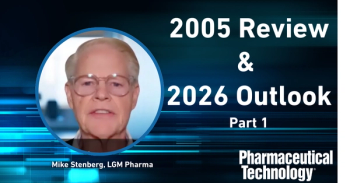
- Pharmaceutical Technology-04-02-2010
- Volume 34
- Issue 4
Inside USP: USP Reaches 2500 Reference Standards
Collaboration has been key to the pharmacopeia's achievement.
How can you tell what something is? For pharmaceuticals, the question is neither philosophical nor speculative, but practical and could mean the difference between life and death. Drugs palliate and cure, and thanks to a burgeoning global pharmaceutical industry, life-saving medicines are reaching more patients who need them. The US Pharmacopeial Convention (USP) helps in this process by providing yardsticks with which manufacturers and regulators can measure the identity, quality, purity, and consistency of drugs. USP works closely with industry to develop monographs and related reference standards (RS)—the yardsticks used as comparison standards in USP tests and assays.
William F. Koch, PhD
USP recently achieved the significant milestone of releasing its 2500th reference standard, a number that is both a cause for celebration and a reminder of continuing challenge. First, the celebration. USP's ability to produce RS has grown substantially in recent years. Production accelerated starting in 2003, with the catalog nearly doubling between then and now. This growth benefits public health in the more than 130 countries in which USP standards are used. The open public process by which USP monographs and RS are developed and revised helps ensure their scientific soundness and the quality of the drugs they are used to assess. The milestone of establishing 2500 RS marks progress in USP's long-term goal of having a monograph and associated RS for all medicines and their ingredients.
Several factors contributed to USP's ability to double its RS in just seven years. For example, the convention gained more resources (i.e., laboratory space and staff) at its expanded Rockville, Maryland, headquarters and facilities in China, Brazil, and India (where a next-phase expansion was recently announced). USP's global presence has helped forge a wide network of partnerships that has yielded collaboration on many compendial projects, including sourcing monographs and reference materials.
In addition, advances in modern analytical methods for characterizing pharmaceuticals and the need to incorporate these methods into routine tests have necessitated development of corresponding RS. An example is the now widespread use of high-performance liquid chromatography (HPLC) methods in quality control and regulatory settings. Quality-control laboratories require a comparator to quantify how much of a material or impurity is in the drug sample—that comparator is a reference standard. Overall, instrument techniques have become more informative, and USP's monographs are similarly evolving to link new and updated standards to corresponding reference materials where needed.
While not typical, the special cases of heparin and glycerin are worth mentioning here if only to underscore the importance of ensuring standards that reflect advances in analytical science and technology. Deaths and adverse reactions resulting from economically motivated adulteration of heparin in 2007 and 2008, and of glycerin on several occasions, called for extraordinary action. Working in concert with the US Food and Drug Administration, other pharmacopeias, and industry, USP developed updated monographs and new RS on an expedited timetable not only for the heparin and glycerin monographs in USP's compendia, but also for dangerous, identified impurities (i.e., oversulfated chondroitin sulfate and dermatan sulfate for heparin, and diethylene glycol and ethylene glycol for glycerin). The updates were made at FDA's request because the public health emergency was pressing. If other dangerous impurities are identified, USP will certainly consider developing standards to help detect them.
Now, the challenge. Twenty-five hundred only looks like a big number until it's compared with the number of monographs and associated RS that USP would like to have for all articles in commerce. The convention intends to reach that goal by working with FDA and industry. Branded and generic drugs are coming into the market continuously, and collaboration with regulators and industry is the way to ensure that these drugs are of uniformly high quality. Manufacturers, regulators, and pharmacopeias alike share the same goal: wide access to safe, high-quality medicines that benefit patients and practitioners.
At USP, sights are set on the next milestone of reaching 3000 RS, which with diligence and ongoing partnership we hope to meet by the end of 2012. There will be many more RS needed. An even more daunting challenge is preventing dangerous adulterants because many chemicals that might pose risks still elude routine quality testing. It will take many talented scientists and policy-makers working together to meet that challenge.
William F. Koch, PhD, is chief standards acquisition and metrology officer for the US Pharmacopeia (USP),
Articles in this issue
over 15 years ago
Tracking Solid-Dosage Equipmentover 15 years ago
Inside EDQM: The Role of the Pharmacopeia in a Globalized Worldover 15 years ago
More Questions than Answersover 15 years ago
Stay Current at INTERPHEXover 15 years ago
Unconventional Communicationover 15 years ago
The Effect of Overencapsulation on Disintegration and Dissolutionover 15 years ago
In the Spotlight April 2010over 15 years ago
Report from AsiaNewsletter
Get the essential updates shaping the future of pharma manufacturing and compliance—subscribe today to Pharmaceutical Technology and never miss a breakthrough.




